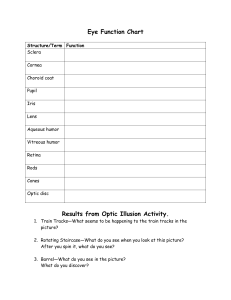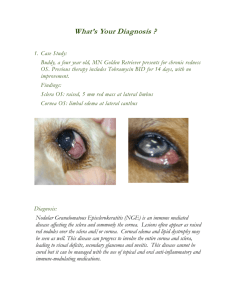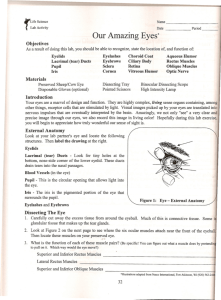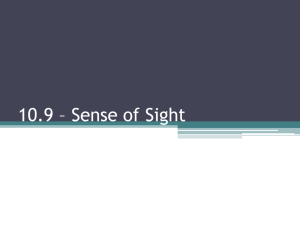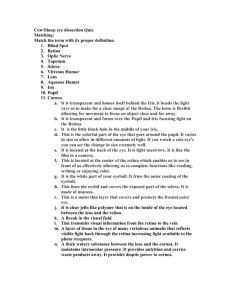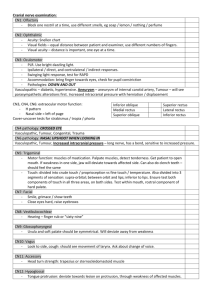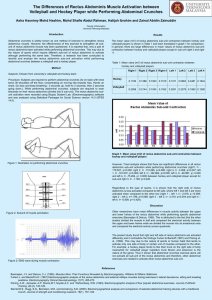Structure and Function of the Eye
advertisement
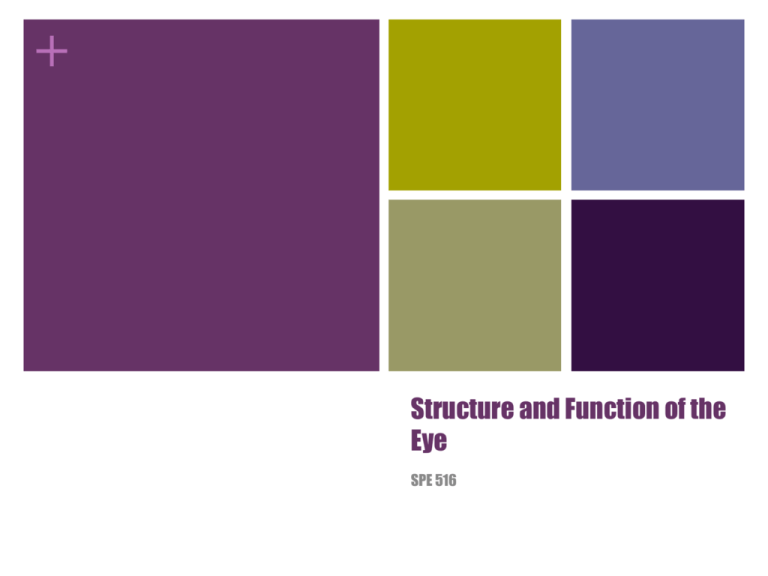
+ Structure and Function of the Eye SPE 516 + The Bony Orbit + The Muscles of the Eye (Extraocular muscles) + Superior and Inferior rectus Superior rectus Attached to the eye at 12 o’clock Moves the eye up. Inferior rectus Attached to the eye at 6 o’clock Moves the eye down. + Lateral Rectus Lateral Rectus Also called the external rectus Attaches on the temporal side of the eye Moves the eye toward the outside of the head (toward the temple) + Medial Rectus Medial Rectus Also called the internal rectus Attached on the nasal side of the eye Moves the eye toward the middle of the head (toward the nose) + Superior Oblique Attached high on the temporal side of the eye. Passes under the Superior Rectus. Moves the eye in a diagonal pattern -- down and in. Travels through the trochlea + Inferior Oblique Attached low on the nasal side of the eye. Passes over the Inferior Rectus. Moves the eye in a diagonal pattern -- up and out. + The Nerves That Control the Muscles of the Eye Third Cranial Nerves Fourth Cranial Nerves Sixth Cranial Nerves + Lids and Lashes Main function is the protection of the eye. They also help to distribute tears which wash and lubricate the eyes. + The Lacrimal System -- Tears + The Refractive Structures These structures bend the light so that a clear image is produced. They are: tears conjunctiva cornea aqueous humor lens vitreous humor + Chambers of the Eye 1. Anterior chamber – from cornea to iris 2. Posterior chamber – from iris to zonules and lens – These two are responsible for the production and drainage of the aqueous which is produced continuously throughout your life. Aqueous is produced in the posterior chamber by the ciliary body travel through the iris to drain out the anterior chamber (through the Canal of Schlemn) 3. Vitreous – gel like –gives the eye its shape not produced – damage or loss can cause retinas to fall or tear + + Layers of the eye Sclera and Cornea uveal tract Choroid Iris Ciliary body retina + Sclera and Cornea Form the outer layer of the eye – 1/6 cornea and 5/6 sclera Cornea is clear- sclera is white (they transition at the limbus) Very tough and provide protection Sclera maintains shape of the eye Cornea is the major refractor of the eye + Uveal Tract Choroid – vascular layer, major supplier of nutrients and blood supply to the eye Iris – Controls light that enters eye Cilliary body- produces aqueous humor to bathe lens and provide nutrients to lens and cornea and provides accommodation. + The Retina The retina is made up of cones and rods Rods -peripheral retina o Motion, low light, no color Cones -central retina o Highly centralized in the fovea o Color o Fine detail + The Optic Pathway Begins at the optic nerve. Impulses cross and partially split at the optic chiasm. After the chiasm, it becomes the optic tract. Lateral geniculate bodies (sensory way stations) Some fibers go to the colliculus (located in the mid brain) + Optic Pathway (cont.) The other fibers fan out into the visual cortex which is located at the top and back of the brain. + Vision and the Brain Primary visual cortex (Striated Cortex) - spatial organization of a scene shapes of objects brightness and shading of parts of objects Secondary visual cortex (Prestriated Cortex) - pattern recognition + The Brain and Vision (cont) Temporal Lobes center for visual learning recognition by sight Midbrain -- Limbic sector emotional responses to visual stimuli Midbrain -- Superior Colliculus - guides visual attention

